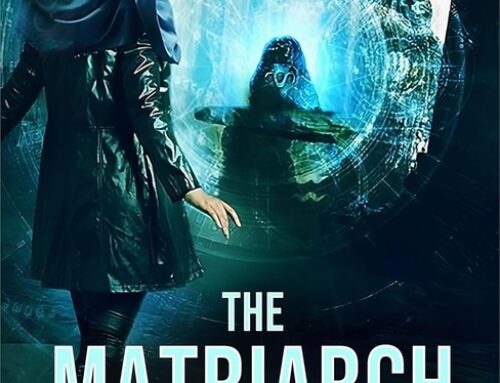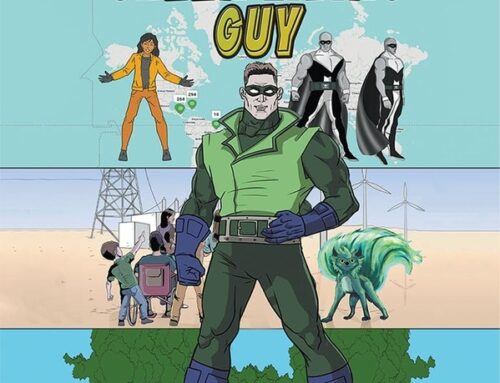From the back cover of Terra Nova: The Search –
In a small central California town, a seismologist working for the United States Geological Survey has made a terrifying discovery. A recent seismic phenomenon is predicting global volcanic activity that threatens to wipe mankind from the face of the earth. Fearing widespread panic and civil disobedience, it is decided to keep the truth a secret from the public. In order to save the human race, the President pushes forward with a dramatic initiative to overhaul NASA and begin a new mission: to colonize deep space.
The newly formed deep space team must harness the technology of researcher and single-dad Tom Scolari, but with their eyes focused on the stars, the odds are against them at home. News of the earth’s demise is on the verge of becoming public, and increasingly violent eruptions continue to mount around the globe. The survival of the human race rests upon the shoulders of a few, and time is running out.
Terra Nova: The Search is a book with a sweeping, epic plot. The destruction of the Earth looms in the immediate future, and bold, coordinated steps are called for to rescue humanity. In the best traditions of Footfall and “Independence Day,” a concerted effort from all of Earth’s societies is our only hope.
Unfortunately, those traditions are let down by the very lack of such a world-wide effort, or even any attempt to begin one. Instead, the plot calls forth a series of loners, beginning with the well-worn movie image of the last employee left in a once-proud laboratory, toiling away unseen and uncared-for, who notices the anomalous data, then moving on to the equally well-known maverick scientist and his “impossible” physics. The effort to save humanity is a very unilateral affair, resting solely with the bureaucracies of the United States, and the story swiftly strangles in its own web of implausibility.
After a very cinematic and completely unnecessary prologue, the story begins in what is either a state-of-the-art seismology lab or a forgotten backwater of science (depending on which paragraph you read), where data streams from three seismographs are apparently recorded on hard drives and ignored, except for quarterly reviews. The sole employee of this lab, when he finds the anomalies which set the story in motion, reports directly to the head of the US Geological Survey. He arranges a meeting in Washington, and when he gets there, he finds the Secretary of Homeland Security is an unexpected third attendee. Leaving the meeting, the Secretary calls the President of the United States to request that he meet with the lab technician from the other side of the nation. The president replies “All right. I’ll clear my schedule.” When the meeting takes place, it seems to be in a hotel conference room. Just the three of them. No aides, no Secret Service, nobody.
Written very much in the mode of a made-for-TV movie, the book strings one implausible scene after another with an eye for visual effect and no thought whatsoever for character motivation or development. The lab technician wipes pizza grease from his fingers into his beard, not because he’s the sort of half-wit who would do such a thing, but because it would look good on camera. The private secretary of the director of the USGS answers the phone as though she’s expecting direct calls from the public, not because such a thing might happen, but because it’s the sort of scene you’d find in a movie on TV.
I believe there’s a strong story buried in here somewhere, but it’s so hidden by the thicket of implausibilities, inconsistencies, and confusing sentence structures that I’m not sure it can ever be heard.
Get an Editorial Review | Get Amazon Sales & Reviews | Get Edited | Get Beta Readers | Enter the SPR Book Awards | Other Marketing Services























Dear FTC;
I was given a copy of this book. Unless someone tells me otherwise, I will keep it. This had no effect on my review.
Thank you for protecting us from the evils of bias caused by filthy lucre.
Sincerely,
Levi
Thanks for the review…though I’m a little disappointed it was from a guest reviewer. Guess it’s tough when there are so many of us. I’m actually curious if you read the whole thing, because everything you mentioned happens in the first 50 pages (and most of it in the first 30). I have no problem getting a bad review, but I’ll disagree on several points.
No character motivation or development? Every character is pushed by something, or struggles with something. There is the single-dad scientist (your maverick…though I’m not sure what makes him a maverick) and his relationship with his teen daughter Megan (you didn’t mention her at all), and the conflict about whether he should tell her about the mission or not, and the lingering pain from losing his wife to cancer. There is Ian who applies to join the colony, and how an abusive home-life has left him “damaged” (also not mentioned). There’s the reporter who is chasing the story of her career, but upon discovering the truth, she struggles with whether she did the right thing (not mentioned). There are members of the deep space team with motives that contradict the US mission, and how there actions unfold and affect the story (not mentioned). There’s the director of the DHS, a former member of the Army who’s life is suddenly changed when news of the earth’s demise comes to light, and how he struggles with his past. There’s the relationship he develops with a young woman named Carmen (not mentioned) as they form a team to protect the physical mission, and the flow of information.
I want people to know there is a lot to the story, and the reviewers odd focus on the first few chapters doesn’t really show the complexity of the plot, the character development, or how each chapter weaves together to reveal the story.
You also said several things that are just incorrect:
“When the meeting takes place, it seems to be in a hotel conference room. Just the three of them. No aides, no Secret Service, nobody.” – As described in that chapter, it was clearly at the USGS headquarters. An excerpt from the very beginning of that chapter:
****Melinda Grant climbed the steps in front of the USGS headquarters and took a deep breath. Secretary Hack had called her in D.C. and explained that they had taken a short break from their meeting and were waiting for her arrival. ****
…and I should mention this very location was described in detail a mere 15 pages earlier.
“The private secretary of the director of the USGS answers the phone as though she’s expecting direct calls from the public” – This was not a call from the public, but from a USGS office. This makes perfect sense.
“The lab technician wipes pizza grease from his fingers into his beard, not because he’s the sort of half-wit who would do such a thing, but because it would look good on camera.” – I don’t think this had anything to do with intelligence, but with personal hygiene.
“Leaving the meeting, the Secretary calls the President of the United States to request that he meet with the lab technician from the other side of the nation. The president replies “All right. I’ll clear my schedule.” – This happens on page 16 to give some perspective to the scope of the review.
Overall, I’m pretty disappointed that most everything mentioned in the review happens within the first 20-30 pages, but I’m glad to have an opportunity to reply.
I guess I’m the first one to be reviewed by a “guest” reviewer. Bummer. Feel free to visit my site, http://www.charltonbooks.com, and look inside the book over at Amazon.com. Thank you to Henry for the opportunity, I just hope the guest reviewers don’t diminish the quality reviews people expect here.
Oh…and just to add to that…what are the inconsistencies you found? You didn’t actually mention any…
One final comment. The reviewer said the following like it was an excerpt:
“The president replies “All right. I’ll clear my schedule.” ”
This is a typo by the reviewer (the text of the books says “alright”, not “all right.”) If you’re going to post excerpts, please don’t give the false impression that the author made typos when they didn’t. Thanks.
That one was my fault. He was right the first time around, but I changed it because alright isn’t technically correct, like alot. We conversed about the change. I’ll let Levi respond to the rest.
That one I have to respond to.
You are correct, the book says “alright.” I considered correcting it to the proper form, “all right,” but, in fact, I did not do so. In the review as I submitted it, the quote said “alright,” and someone at Self-Publishing Review corrected it.
If you’re going to insist on the typos from the book being replicated, please don’t give the false impression that the reviewer is to blame. Thanks.
Levi
Since this is not my site (I am, after all, but a lowly guest reviewer), I sought counsel from Henry Baum as to whether to respond or not. He said to do so, so here is my response:
It’s probably best to just let this drop, but since my integrity and the quality of my review, as well as the judgment of Self-Publishing Review, seem to have been called into question, I thought I would at least enumerate my responses.
I have copied (most of) the content of Mr Charlton’s comment, and will interleave my responses.
{begin quote}
Author: Nathan Charlton
Comment:
Thanks for the review…though I’m a little disappointed it was from a guest reviewer. {I’m not quite sure how that’s even relevant — LM} Guess it’s tough when there are so many of us. I’m actually curious if you read the whole thing {I didn’t — LM}, because everything you mentioned happens in the first 50 pages (and most of it in the first 30). I have no problem getting a bad review, but I’ll disagree on several points.
No character motivation or development? Every character is pushed by something, or struggles with something. There is the single-dad scientist (your maverick…though I’m not sure what makes him a maverick {The fact that he is pursuing a goal that “normal” physics has declared impossible, which makes him the modern equivalent of the man who builds a rocket in his back yard in 50’s pulp fiction. Bear in mind that I read a lot of those stories, and enjoyed them. There’s nothing wrong with the maverick himself, but I don;t think this was the story for him. — LM}) and his relationship with his teen daughter Megan (you didn’t mention her at all), and the conflict about whether he should tell her about the mission or not, and the lingering pain from losing his wife to cancer. There is Ian who applies to join the colony, and how an abusive home-life has left him “damaged” (also not mentioned). There’s the reporter who is chasing the story of her career, but upon discovering the truth, she struggles with whether she did the right thing (not mentioned). There are members of the deep space team with motives that contradict the US mission, and how there [sic] actions unfold and affect the story (not mentioned). There’s the director of the DHS, a former member of the Army who’s [sic] life is suddenly changed when news of the earth’s demise comes to light, and how he struggles with his past. There’s the relationship he develops with a young woman named Carmen (not mentioned) as they form a team to protect the physical mission, and the flow of information. {In my view, none of this is very relevant to any of the points made in the review, but for the record, it’s all pretty shallow “development.” None of it can overcome the general implausibility level. — LM}
I want people to know there is a lot to the story, and the reviewers [sic] odd focus on the first few chapters doesn’t really show the complexity of the plot {the complexity of the plot is seriously overshadowed by its implausibilty — LM} , the character development {again, there really isn’t any — LM} , or how each chapter weaves together to reveal the story.
You also said several things that are just incorrect:
“When the meeting takes place, it seems to be in a hotel conference room. Just the three of them. No aides, no Secret Service, nobody.” – As described in that chapter, it was clearly at the USGS headquarters. An excerpt from the very beginning of that chapter:
****Melinda Grant climbed the steps in front of the USGS headquarters and took a deep breath. Secretary Hack had called her in D.C. and explained that they had taken a short break from their meeting and were waiting for her arrival. ****
…and I should mention this very location was described in detail a mere 15 pages earlier.
{Actually, the quote he gives is from the beginning of the next chapter, and I honestly thought it was referring to a second meeting. The entire beginning of the chapter in which the meeting I described takes place [annotated by LM]}:
“For the last two days Max Burton had worked non-stop [lack of comma is his, not mine] subsisting on caffeine and candy from the hotel [location given as “hotel”] snack machine.
His findings were devastating.
Earlier that morning he had setup [sic] a small presentation in the conference room [assumption: location has not changed, since there has been no mention of such a change, and is therefore still in the hotel] The fan of an LCD projector whirred on the conference room table. Shortly after 9 [sic] a.m. Bruce, Michael Hack, and one guest arrived.
Max recognized the third man instantly. President Francis Patrick Harper…”
{I said the meeting “seems” to take place in the hotel conference room, because that is, indeed, where it “seems” to take place. — LM}
“The private secretary of the director of the USGS answers the phone as though she’s expecting direct calls from the public” – This was not a call from the public, but from a USGS office. This makes perfect sense. {Yes, indeed, that was my point: she answers the call (from a USGS office) as though she (the personal secretary of the director of the USGS) is expecting calls from the public. — LM}
“The lab technician wipes pizza grease from his fingers into his beard, not because he’s the sort of half-wit who would do such a thing, but because it would look good on camera.” – I don’t think this had anything to do with intelligence, but with personal hygiene. {As a man who has worn a full beard for most of my life, and who has known many more such men, let me assure you, the sort of man who would wipe pizza grease in his beard is a half-wit. — LM}
“Leaving the meeting, the Secretary calls the President of the United States to request that he meet with the lab technician from the other side of the nation. The president replies “All right. I’ll clear my schedule.” – This happens on page 16 to give some perspective to the scope of the review. {Two points here: 1) the quote (as submitted in my review) actually says “alright,” which is an error in its own right, and 2) my point was that the President would not “clear [his] schedule” for such a meeting. The depth into the book at which this occurs is hardly relevant. — LM}
Overall, I’m pretty disappointed that most everything mentioned in the review happens within the first 20-30 pages, but I’m glad to have an opportunity to reply.
I guess I’m the first one to be reviewed by a “guest” reviewer. Bummer.
{end quote from comment}
I’m quite certain that if Mr Charlton were to peruse the reviews on Self-Publishing Review, he would find that neither the tone of my review not the points made are seriously out of step with those of other reviewers posting on this site. I also would like to point out that I made no mention at all of the frequent errors of diction, syntax, grammar, etc (such as the use of “setup” for “set up,” “alright” for “all right,” and “9 a.m.” for “nine a.m.” or “9:00 a.m.” in the quotes above), nor the errors in book design, such as allowing the line count on facing pages to vary, sometimes by as much as four lines.
All in all, I feel that I gave an honest and fair review. I admit I had a hard time deciding whether to address the level of the writing, the design of the book (which I feel is extremely relevant when reviewing a self-published book), or the implausibility of the plot, but in the end, I decided that the plot was what most readers would be interested in.
Whether any or all of this should be published, and whether such publication should be as a comment or as a new post, is entirely up to you, but I thank you for both the opportunity to review this book, and the patience to listen to me whine about Mr Charlton’s response. I do hope I will be able to review more books for you in the future.
Thank you.
Thanks for the reply. I won’t bother to nit-pick every response, but I’ll point out that you missed the really big letters at the beginning of the “hotel” chapter that read:
“United States Geological Survey
Reston, VA”
(Not to mention that chapter occured shortly after they decided they would get back together in a couple days).
But if you’re going to review books, and get hung up on something like 9 a.m. being improper, and then stop after the first few chapters…don’t present your review like you’ve read the whole thing. And how do you really pass judgement on the plot as implausible when you only read a fraction of the plot? (I’m guessing 50 pages out of 350). All the science is based on actual theories…but I guess you found certain information like the Deccan Traps completely implausible (oh wait, that actually happened). You go on and on that it’s implausible…but give no explanation why. The entire thing is so vague and general that I can’t help but feel you only skimmed the first couple chapters.
I’d LOVE it if my book could be completely error free, and trust me, I’ve fixed several things since it came out…but the errors are minor (and few and far between). If self-publishing review is going to farm out reviews, shouldn’t there at least be a standard that you should read the WHOLE book?
Good discussion.
http://www.merriam-webster.com/dictionary/alright
I maintain that it is entirely reasonable to expect that the location clues given in context will actually be meaningful. The meeting seems to take place in the hotel conference room, the chapter heading notwithstanding.
I actually read the Prologue and Part One, which would be something over seventy pages, and I neither stated not implied otherwise.
In those seventy-plus pages, there is scarcely a two-page spread without an error in diction, syntax, grammar or punctuation. This hardly counts as few and far between. As to minor, some of the sentences needed to be read two or three times.
You accuse me of being vague on my claims of implausibility, and attempt to divert the discussion to the science in the book, rather than the book itself. Let me be more specific:
“…the story begins in what is either a state-of-the-art seismology lab or a forgotten backwater of science (depending on which paragraph you read)…” I find it implausible that such a dichotomy would exist.
“…where data streams from three seismographs are apparently recorded on hard drives and ignored, except for quarterly reviews…” I find this implausible.
“…The sole employee of this lab … reports directly to the head of the US Geological Survey…” I find it implausible that there is no chain of command in place.
“…when he gets [to the meeting], he finds the Secretary of Homeland Security is an unexpected third attendee…” I find it implausible that a cabinet-level Secretary would attend such a meeting, especially on short notice.
“…The president replies “Alright. I’ll clear my schedule…” I find it implausible that the President of the United States would a) set his own schedule at all, and b) clear his schedule for such a meeting.
“…When the meeting takes place, it seems to be … the three of them. No aides, no Secret Service, nobody…” I find this implausible.
Your ball. I’ve said all I’m going to.
Levi
Doesn’t a review of a book imply that you read the whole thing…unless you state differently?
I’m sorry you found so many things implausible.
I don’t see what’s so implausible about a scientist working alone in a lab where most things have become automated.
Or what’s implausible about something real called SAFOD (http://www.earthscope.org/observatories/safod.You) said the data from this was ignored…but I don’t think this was ever said in the book. You find real earthquake monitoring systems and seismic prediction models implausibe? That stuff is real….how is it implausible?
I don’t know what’s implausible about a USGS field scientist reporting to an old friend (the current head of the USGS) when something catastrophic could be looming. Perhaps an email to a mid-level manager, and then several exciting chapters where the data is slowly pushed up to the head of the USGS would have been a better idea. Wait…
I don’t think it’s implausible that the head of the DHS would be called to see the data, and then after that the President become involved (would you have preferred the President say he doesn’t control his schedule, and would get around to it in a couple weeks or so?)
I don’t think it’s implausible that the meetings would be small (of which there were really three different meetings, each growing in number to a total of 5). The containment of information was important, and to be reckless with that would have made it unbelievable that the info could be contained later on.
But at least we are clear now on where we disagree, and it’s clear that your opinion is based on only a portion of the book. Off to read some more snippets from your books on Amazon…
Oh, and still waiting for the inconsistencies….
Just for the point of clarity, I loved this book.
Sure it wasn’t best selling, wasn’t firmly rooted in reality(what Sci-Fi book is?), and maybe characters didn’t change in a way that stirred my heart, BUT this was a first time author. Give him a break.
It was a good read and Charlton shouldn’t be cheated out by this lame review.
Levi, you need to cut your beard and maybe actually finish a book before you review it.
Please don’t let this devolve into a thread where friends defend Nathan Charlton’s honor. I didn’t know Levi Montgomery hadn’t read the whole book. And didn’t assume I had to include the criteria – “in order to review the book you have to read it.” This “Call Out for Reviewers” is an experiment to see if more reviews can come in, but it may just turn out to be less is more.
That said, I don’t think it’s a good thing to defend your novel like this. Many people reading this review won’t know who’s right and all these criticisms aren’t really persuasive that your book is good, it just makes you look defensive – even if you’re right.
Interesting about “Alright.” I still think “all right” looks better, especially when coming out of a president’s mouth who’s supposed to be showing authority.
I agree, arguing little points like “alright” isn’t very useful. However, if the discussion brought to light that the reviewer didn’t even read the whole book (yet still makes claims like not enough character development), then I think it was a worthwhile discussion.
If that makes me look defensive, so be it. People are welcome to check the book out and decide for themselves.
Hmmm…I have to disagree with you on the grammatical errors. If there are errors in grammar they should be pointed out. How often do you read best selling books where grammatical errors abound? Unless it is a colloquialism, I think we should stick to the proper spelling. Any publisher would request this spelling.
Secondly, I don’t think it is uncommon for a reviewer to give a review without finishing the book. I think the reviewer’s only fault lies in the fact that he did not come out and say, “I did not finish this book and these are the reasons why”.
Having that said, I wish you the best of luck Nathan Charlton.
DISCLOSURE: I only skimmed these comments.
COMMENT: This happened with Roger Ebert on a film review earlier this year – upon reflection and reaction, he decided he should’ve disclosed at the beginning of his review that he didn’t finish the movie.
CONCLUSION: Nothing.
Hi Levi, I found this review useful and understand the difficulty that arises when your review is reviewed. I hope you review more books in the future. Please do mention in future reviews how much of the book you’ve read, however. I’ve seen reviewers not finish the book before, but they often mention it in the text of their reviews. It’s usually a good indicator of the quality of the book – it says a lot when a book’s not worth finishing.
I also find grammar and syntax errors worth at least a cursory mention on top of the plot and such. It’s sort of a commentary on whether a product is ‘defective’ or not. Because us self-pub folks want self-pub books to be the equal. or surpass, mainstream trad books, it’s important that the self-pub books reviewed are held to a high standard. If a book fails to meet that standard, don’t be afraid to mention it.
It’s hard being a critic, especially in the face of someone whose darling you’ve just (by their interpretation) insulted. I write, myself, and find reviews very useful, but unless the review makes blatantly false claims (which yours, even held up to the author’s defense, doesn’t seem to) I tend to leave it alone, or just give a simple “thanks”. In my opinion I make the case for a story when I write the story. Keep on trucking.
I don’t know what all the fuss is about. Nathan has some great blurb potential in this review:
“Terra Nova: The Search is a book with a sweeping, epic plot… a strong story…” – Levi Montgomery, author of Cursing the Cougar and Stubbs and Bernadette.
This is a good experiment, Henry. And you’re right, good, bad, or indifferent, an author is better off not getting too defensive about a review. Just take it all in stride, and if the author must respond in the comments, be brief with a clarification, be courteous to the reviewer and above all, be gracious. Such an approach seems to me to be the more productive rebuttal.
Funny enough, I too used “alright” in my novel, a carryover from my newspaper days. But my bigger regret is using “OK” instead of “okay.” What was I thinking?
Authors,
You can’t complain about a bad review. You put your work out there; the reviewer responds as he sees it. That’s it. PERIOD.
You may get some good reviews; you may get some bad. That’s life.
Darryl
The author was hardly complaining. It took him halfway through these comments just to prove he got a shady review. Can’t blame him for that.
It doesn’t mean his book is any good, but it tells me the review was poorly written.
It’s hilarious to see someone try to defend their story after a bad review, even if they read all or part. Even the people (relatives of the writer) who tried to agree just look plain foolish.
This review didn’t make me not want to buy it, the response of the author did.
1. Take it like a man that in the first 50 pages there were grammatical errors abound, the plot to some was weak, and not everyone will like it.
2. State somewhere if this is or isn’t related to the T.V. show. Did you come up with this before or after. Because to me, it’s like naming a book heroes: the search, a weak attempt at a google search self promotion. Because the author isn’t mentioned anywhere on Wikipedia or another online source.
3. Learn and move on.
To the last guy…this review came out in 2009….the show was out last year. Before you dog the guy, maybe you should learn how time works.